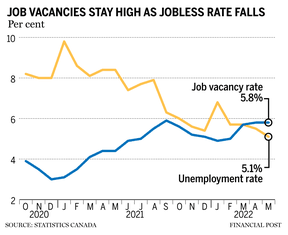There were 1,005,700 positions unfilled at the beginning of May — 42% higher than a year ago

Article content
Job vacancies, an economic indicator that Bank of Canada governor Tiff Macklem is watching closely, climbed to a record in May, as employers continue to struggle to fill jobs in the heated labour market.
Advertisement 2
Article content
Statistics Canada reported July 28 that there were 1,005,700 unfilled positions at the beginning of May, up slightly from 1,001,100 in April, the previous record. The May number was 42 per cent higher than a year earlier.
Vacancies are an important sign of what the Bank of Canada calls “excess demand,” as the inability of companies to hire enough people to keep up with orders suggests the economy is unable to supply all the goods and services consumers and companies are seeking to buy. The mismatch is one of the factors driving inflation to its fastest in four decades, prompting Macklem to raise the benchmark interest rate by a full percentage point earlier this month.

“When it comes to inflation, one of the ways the economy sort of feeds into prices is that strong demand for workers creates the conditions for stronger wage growth,” said Brendon Bernard, senior economist at Indeed, the hiring site owned by Japan’s Recruit Holdings Co. Ltd. “That cost of labour starts influencing the pace of (pricing).”
Advertisement 3
Article content
Statistics Canada said the job vacancy rate remained at 5.8 per cent for a second consecutive month, compared to the unemployment rate in May of 5.1 per cent. This 1:1 unemployment-to-job-vacancy ratio is down from last year’s 2:4.
This lower unemployment-to-job-vacancy ratio indicates a tighter labour market and possible labour shortages, the agency said.
“(This is) a sign that Canadians who are looking for work are increasingly able to find it but at the same time, filling job openings for employers is more challenging than it has been in the past,” said Bernard.
Vacancies in accommodation and food services remained the highest, with 161,100 vacant positions in May, a slight change from the previous month. The vacancy rate was 11.9 per cent, representing the thirteenth consecutive month that hotels and restaurants reported the highest percentage of unfilled positions among the total jobs — filled and unfilled — available in the industry.
Advertisement 4
Article content
“The high level of job vacancies in this sector reflects the difficulties faced by employers seeking to attract and retain workers,” Statistics Canada said.
Other sectors, including retail trade, manufacturing, construction, and transportation and warehousing, saw little change in May. Pandemic-induced job vacancies in health care and social assistance increased 14.5 per cent to 143,400 in May, offsetting the previous month’s decline.
Nova Scotia and Manitoba reached record high job vacancies in May, led by the provinces’ accommodation and food services sectors.
Meanwhile, May’s payroll employment — the number of employees receiving pay or benefits from their employer — saw the first decline since May 2021 with a 0.1 per cent dip from April. Ontario and Manitoba recorded the largest losses, while British Columbia was the only province recording an increase in payroll employment.
Advertisement 5
Article content
-

Tiff Macklem’s soft landing could rest with business confidence
-

Canada’s jobless rate drops to record low of 4.9%: What you need to know
-

Canada to fall into ‘moderate and short-lived’ recession next year, RBC warns
-

Job vacancies in Canada surge to new high: What you need to know

Construction led decreases in payroll employment among goods-producing sectors with a drop of 17,500, the first monthly decline since July 2021. Losses in the services-producing sector were spread across industries including education, health and retail trade.
Statistics Canada also recorded a 2.5 per cent increase in average weekly earnings from May 2021, despite the consumer price index increasing by 7.7 per cent over the same period. The wage increase was slower than in April and March, despite the increase in vacancies.
A report released by Indeed Canada on Thursday found that the total number of Canadian job postings on the hiring site was down five per cent in June after reaching a high-point in early May, suggesting that hiring may have peaked.
“With a cloudy economic outlook, I don’t think it’s surprising that we’ve seen employer hiring appetite cool a bit in recent weeks,” Bernard said.
• Email: dpaglinawan@postmedia.com | Twitter: denisepglnwn


